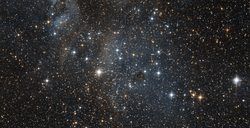Astronomy:NGC 1858
From HandWiki
Short description: Open cluster in the constellation Dorado
| NGC 1858 | |
|---|---|
 The open cluster NGC 1858 | |
| Observation data (J2000 epoch) | |
| Constellation | Dorado |
| Right ascension | 05h 09m 51.9s[1] |
| Declination | −68° 53′ 28″[1] |
| Apparent magnitude (V) | 9.9 (visible) 9.8 (B-Band)[2] |
| Physical characteristics | |
| Estimated age | 8 million[3] |
| Other designations | ESO 56-SC74, Dunlop 120 |
NGC 1858 (also known as ESO 56-SC74) is a bright, large, irregular open cluster and emission nebula. It is found in the Dorado constellation. It is located in the Large Magellanic Cloud. It was first discovered by James Dunlop on August 3, 1826, and was first recorded as Dunlop 120. John Herschel recorded it on November 2, 1834. However, at the time, he did not associate it with Dunlop 120. Astronomers have now realised that Dunlop 120 and NGC 1858 are the same object.[2]
See also
References
- ↑ 1.0 1.1 "NED results for object NGC 1858". NASA/IPAC EXTRAGALACTIC DATABASE. http://ned.ipac.caltech.edu/cgi-bin/nph-objsearch?objname=NGC+1858&img_stamp=yes&extend=no.
- ↑ 2.0 2.1 "NGC 1858 (= an OCL and EN in the LMC)". cseligman. http://cseligman.com/text/atlas/ngc18a.htm#1858.
- ↑ Vallenari, A.; Aparicio, A.; Fagotto, F.; Chiosi, C.; Ortolani, S.; Meylan, G. (1994). "Active star formation regions at the edge of the LMC Bar: NGC 1850 and NGC 1858". Astronomy and Astrophysics 284: 447. Bibcode: 1994A&A...284..447V.
External links
 |

